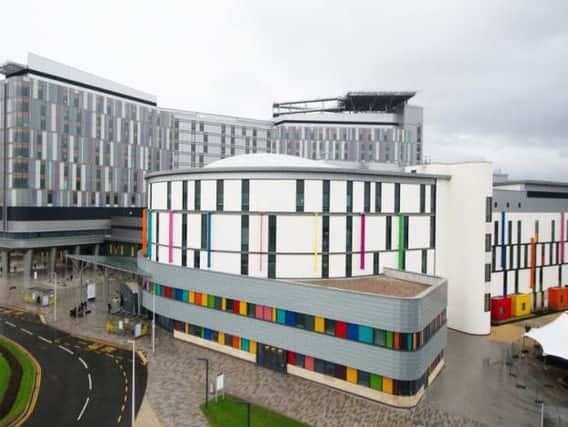Grenfell Tower insulation also used in new Glasgow hospital


However, NHS Greater Glasgow and Clyde (NHSGGC) said it had been assured by the builder they had been fitted correctly and were safe.
The Kingspan Kooltherm K15 Rainscreen board helped Scotland’s largest hospital achieve an “excellent” insulation rating, their manufacturer said.
Advertisement
Hide AdAdvertisement
Hide AdKingspan said they comprised less than 5 per cent of the insulation in Grenfell’s cladding.
It is also thought they were combined with different materials in the London block’s cladding than at the 14-storey Glasgow hospital.
Kingspan said the panels had been used on Grenfell without its knowledge, and it would “never recommend” them being combined with Celtex RS5000 panels, another type of insulation found at Grenfell.
At least 80 people are thought to have died when the 24-storey block was engulfed by flames almost one month ago.
The Kooltherm panels have a high resistance to stopping the spread of fire, but are still classified as combustible.
They are believed to have been installed at Grenfell beneath rainproof cladding Reynobond PE, which has also been identified as combustible.
NHSGGC said it had no plans to remove the insulation and said the hospital was "one of the safest buildings in the UK in terms of fire engineering".
A spokesman said: "Multiplex, the main contractor for the hospital construction, have assured NHSGGC that the Kingspan Kooltherm K15 insulation boards were properly installed to meet Scotland’s stringent building and fire safety regulations.
Advertisement
Hide AdAdvertisement
Hide Ad"The hospital itself is designed and equipped to the highest standards for fire safety.
"It has heat/smoke detection and early warning fire alarm systems combined with automatic fire suppression sprinkler systems fitted in all areas.
"The hospital patients, staff and visitors are further protected by designated fire fighting and fire evacuation lifts, as well as multiple fire escape stairwells."
A Kingspan spokesman said: “Kingspan had no involvement in either the design or the specification of the refurbishment of the Grenfell Tower facade, and neither Kingspan insulated panels nor Kingspan façade systems were used on Grenfell Tower.
“To the best of our knowledge, the vast majority of the insulation used for the façade refurbishment was PIR (polyisocyanurate) that had no connection with Kingspan.
“However, subsequent to the Grenfell tragedy we became aware that a very small quantity of Kingspan Kooltherm K15 (less than 5 per cent of the estimated total amount of insulation used on the tower facade) was sourced by a third party distributor and supplied to contractors involved in the refurbishment.
“Whilst we are still seeking to establish the facts of what occurred, it appears that Kooltherm K15 has been used without our knowledge, as part of a combination for which it was not designed, and which Kingspan would never recommend.
“Kingspan is very confident that properly installed and specified our products deliver safe, reliable and energy efficient insulation solutions.
“K15 has the advantage of excellent fire performance.
Advertisement
Hide AdAdvertisement
Hide Ad“Importantly, it does not readily propagate fire and ultimately it self-extinguishes whilst substantially mitigating smoke release.
“Our research, using large-scale fire tests on ventilated rainscreen systems, shows that systems containing Kooltherm K15 can display similar fire performance to systems containing mineral fibre products that are deemed non-combustible.”